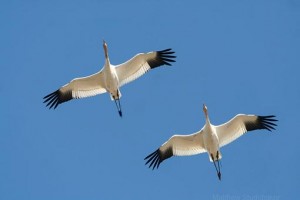Community Expresses Clear Desire for Accurate and Timely Whooping Crane Data
by Ron Outen, Regional Director, The Aransas Project
A public meeting held by the Aransas National Wildlife Refuge staff in Fulton to provide information about changes in tracking and reporting the numbers of endangered whooping cranes wintering at the Refuge was well-attended by the community as well as by local elected officials.
The Oct. 4 meeting followed on the heels of USFWS’s Oct. 3 release of a report that they titled,, “Aransas-Wood Buffalo Whooping Crane Abundance Survey (2011-2012).” In addition to providing information on the new distance sampling method employed for the first time during the winter of 2011-2012, the report was critical of the census methods employed for nearly 30 years by retired Refuge Biologist and International Whooping Crane Recovery Coordinator Tom Stehn, and even before that dating back to the 1950’s.
The presentation was led by current Refuge Biologist Brad Strobel, who did an admirable job of laying out the history of the way in which the cranes had been counted at the Refuge, as well as sharing information on the development of the new distance sampling method being used to provide a point estimate of the crane population on the Refuge last winter, which he described as a “work in progress.”
In contrast to USFWS’ written report, Strobel had abundant praise for Stehn’s work, and repeatedly noted that he wished he could “channel Tom Stehn” to arrive at precise counts. “If there was a way that I could channel Tom and do it the same way that Tom did it, believe me I would.” explained Refuge Biologist Brad Strobel. Other Refuge staff also in attendance included Refuge Manager Dan Alonso and newly named Whooping Crane Recovery Coordinator Dr. Wade Harrell.
As soon as the Question and Answer period began, it was immediately clear how passionate, engaged and informed this community is about the whooping crane. A few highlights included:
Demand for Accurate Information on Number of Cranes to Continue: Community members frequently noted in their comments and question that they, and people all over the world, expected regular information on the number of cranes in the flock. As one audience member put it, “I need to know how many whooping cranes are here, how many of them die or disappear, and why.” There was extensive discussion of how far off the peak estimate of 254 cranes could be, and it was agreed that the variance could be as much as plus/minus 30 birds.
New Method Focuses Solely on Population, Not Mortality: Strobel acknowledged that the new method focuses solely on estimating population and does not measure mortality (which is unknown for the winter of 2011-2012), while also noting that “winter mortality is a critical metric.”
Need for Public Input: The audience was extremely interested in how the new distance sampling method had been developed, and in who had input in the creation of the protocol. Strobel indicated that he had developed the new protocol along with members of the USFWS regional staff, including himself, regional Biometrician Matt Butler and Regional Chief of Biosciences Grant Harris. While Refuge staff indicated that the new protocol would be peer-reviewed by experts only, the audience expressed the need for broader public review and comment.
Better and More Timely Communication: Nancy Brown, USFWS Public Outreach Specialist, who invited questions about communication to her at nancy_brown@fws.gov and indicated that USFWS was in the process of developing a new website to enable better communication, but in the meantime, the current website would continue to be updated at least every two weeks with information. Notices of upcoming meetings, as well as the presentation and FAQ sheet from last night’s meeting will be made available.
While it is clear that there remain a great number of questions to be examined with respect to the tracking and management of the flock, the meeting was a positive first step in creating a community dialogue on this important issue. The Refuge staff plans to do additional public meetings, with the next meeting to be held at the Refuge on October 24th. TAP will continue to keep you informed on this critical issue.


